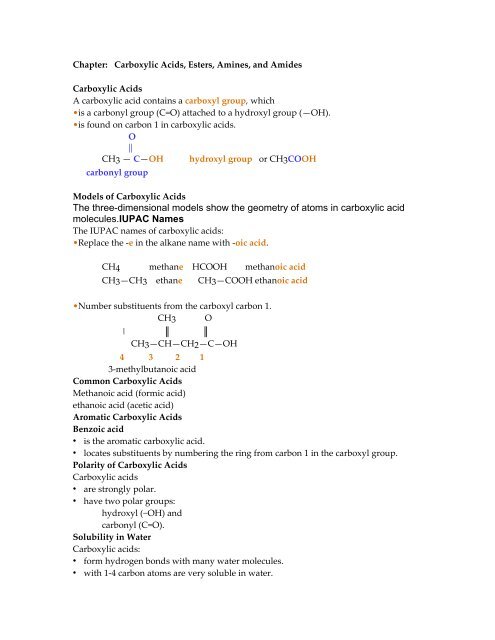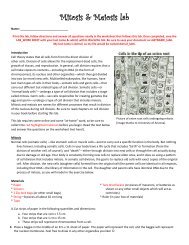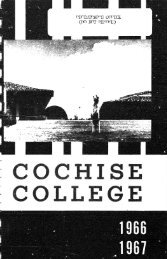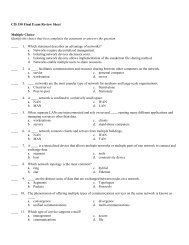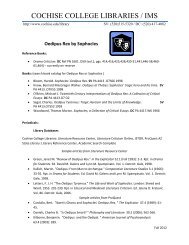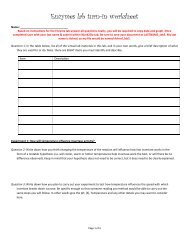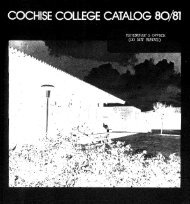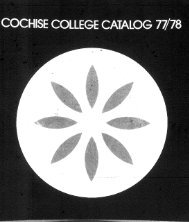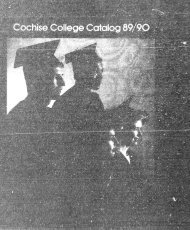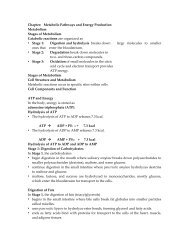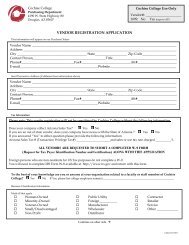Chapter 13 Carboxylic Acids, Esters, Amines, and Amides
Chapter 13 Carboxylic Acids, Esters, Amines, and Amides
Chapter 13 Carboxylic Acids, Esters, Amines, and Amides
- No tags were found...
You also want an ePaper? Increase the reach of your titles
YUMPU automatically turns print PDFs into web optimized ePapers that Google loves.
<strong>Chapter</strong>: <strong>Carboxylic</strong> <strong>Acids</strong>, <strong>Esters</strong>, <strong>Amines</strong>, <strong>and</strong> <strong>Amides</strong><strong>Carboxylic</strong> <strong>Acids</strong>A carboxylic acid contains a carboxyl group, which•is a carbonyl group (C=O) attached to a hydroxyl group (—OH).•is found on carbon 1 in carboxylic acids.O||CH3 — C—OH hydroxyl group or CH3COOHcarbonyl groupModels of <strong>Carboxylic</strong> <strong>Acids</strong>The three-dimensional models show the geometry of atoms in carboxylic acidmolecules.IUPAC NamesThe IUPAC names of carboxylic acids:•Replace the ‐e in the alkane name with ‐oic acid.CH4 methane HCOOH methanoic acidCH3—CH3 ethane CH3—COOH ethanoic acid•Number substituents from the carboxyl carbon 1.CH3 O| ║ ║CH3—CH—CH2—C—OH4 3 2 <strong>13</strong>‐methylbutanoic acidCommon <strong>Carboxylic</strong> <strong>Acids</strong>Methanoic acid (formic acid)ethanoic acid (acetic acid)Aromatic <strong>Carboxylic</strong> <strong>Acids</strong>Benzoic acid• is the aromatic carboxylic acid.• locates substituents by numbering the ring from carbon 1 in the carboxyl group.Polarity of <strong>Carboxylic</strong> <strong>Acids</strong><strong>Carboxylic</strong> acids• are strongly polar.• have two polar groups:hydroxyl (−OH) <strong>and</strong>carbonyl (C=O).Solubility in Water<strong>Carboxylic</strong> acids:• form hydrogen bonds with many water molecules.• with 1‐4 carbon atoms are very soluble in water.
Acidity of <strong>Carboxylic</strong> <strong>Acids</strong><strong>Carboxylic</strong> acids• are weak acids.• ionize in water to produce carboxylate ions<strong>and</strong> hydronium ions.Neutralization of <strong>Carboxylic</strong> <strong>Acids</strong><strong>Carboxylic</strong> acid salts• are a product of the neutralization of a carboxylic acid with a strong base.CH3—COOH + NaOH CH3—COO – Na + + H2Oacetic acidsodium acetate(carboxylic acid salt)• are used as preservatives <strong>and</strong> flavor enhancers.<strong>Esters</strong>In an ester, the H in the carboxyl group is replacedwith an alkyl group.CH3 — C—O —CH3ester groupEsterification is the reaction of a carboxylic acid <strong>and</strong> alcohol in the presence of an acidcatalyst to produce an ester.O|| H +CH3—C—OH + H—O—CH2—CH3 _______________________>O||CH3—C—O—CH2—CH3 + H2Oethyl acetate (an ester)Ester ProductsAspirin• is used to relieve pain <strong>and</strong> reduce inflammation.• is an ester of salicylic acid <strong>and</strong> acetic acid.Oil of wintergreen• is used to soothe sore muscles.• is an ester of salicylic acid <strong>and</strong> methanol.Naming <strong>Esters</strong>The name of an ester contains the names of• the alkyl group from the alcohol.• the carbon chain from the acid with –ate ending.methylethanoate (acetate)O||CH3— O—C —CH3IUPAC: methyl ethanoate
<strong>Esters</strong> in Plants<strong>Esters</strong> give flowers <strong>and</strong> fruits their pleasant fragrances <strong>and</strong> flavors.Base hydrolysis or saponification,• is the reaction of an ester with a strong base.• produces the salt of the carboxylic acid <strong>and</strong> an alcohol.Cleaning Action of Soap• contains a nonpolar end that dissolves in nonpolar fats <strong>and</strong> oils, <strong>and</strong> a polar end thatdissolves in water.• forms groups of soap molecules called micelles that dissolve in water <strong>and</strong> are washedaway.<strong>Amines</strong>• are derivatives of ammonia, NH3.• contain N attached to one or more alkyl or aromatic groups.CH3⏐CH3⏐CH3—NH2 CH3—NH CH3—N—CH3Classification of <strong>Amines</strong><strong>Amines</strong> are classified as primary, secondary, or tertiary.• In a primary (1°) amine, one carbon group is bonded to the nitrogen atom.• A secondary (2°) amine has two carbon groups bonded to the nitrogen atom.• A tertiary (3°) amine has three carbon groups bonded to the nitrogen atom.H CH3 CH3| | |CH3—N—H CH3—N—H CH3—N—CH31° 2° 3°Models of <strong>Amines</strong>The three‐dimensional models show the shapes of amine molecules with one or morealkyl groups bonded to the nitrogen atom.Naming <strong>Amines</strong>Simple amines• are named as alkylamines.• List the names of the alkyl groups bonded to the N atom in alphabetical order in frontof amine.CH3—CH2—NH2 ethylamineCH3—NH—CH3 dimethylamineCH3|CH3—N—CH2—CH3ethyldimethylamine
Aromatic <strong>Amines</strong>• The amine of benzene is named aniline.• Alkyl groups on the N use the prefix N‐ with alkyl name.aniline 3‐chloroaniline N‐methylanilineHydrogen Bonding for <strong>Amines</strong>The N−H bond• provides hydrogen bonding in 1°<strong>and</strong> 2° amines, but not in 3° amines.• is not as polar as the O‐H bonds in alcohols.Solubility in Water<strong>Amines</strong>• with 1‐5 carbon atoms are soluble in water.• form hydrogen bonds with the polar O‐H bond in water.<strong>Amines</strong> React as BasesLike ammonia, amines are weak bases in water.NH3 + H2O NH4 + + OH –ammonium hydroxideCH3—NH2 + H2O CH3—NH3 + + OH –methylammonium hydroxideNeutralization forms Amine SaltsAn amine salt• forms when an amine is neutralized by acid.• is named by replacing the amine part of the name with ammonium followed by thename of the negative ion.CH3—NH2 + HCl CH3—NH3 + Cl –methylamine methylammonium chlorideProperties of Amine SaltsAmine salts are• solids at room temperature.• soluble in water <strong>and</strong> body fluids.• the form used for drugs.Alkaloids are• physiologically active nitrogen‐containing compounds.• obtained from plants.• used as anesthetics, antidepressants, <strong>and</strong> in stimulants such as caffeine.• often addictive.Cocaine• sold illegally as the amine salt.• reacted with NaOH to produce the free amine form known as “crack.”
Caffeine• is a stimulant of the central nervous system.• is found in coffee beans, tea, chocolate, <strong>and</strong> soft drinks.Nicotine• increases the adrenaline level in the blood.• causes addiction to tobacco.Morphine <strong>and</strong> Codeine• alkaloids.• obtained from the oriental poppy plant.• used as painkillers.• modified to make heroin.<strong>Amides</strong>In amides,• an amino group(–NH2) replaces the –OH group of carboxylic acids.OO|| ||CH3—C—OHCH3—C—NH2Aromatic AmideThe aromatic amine is benzamide.Preparation of <strong>Amides</strong><strong>Amides</strong> are produced• by reacting a carboxylic acid with ammoniaor an amine (1° or 2°).• using heat.OO|| Heat ||CH3—C—OH + NH3 CH3—C—NH2 + H2OOO|| Heat ||CH3—C—OH + CH3—NH2 CH3—C—NH—CH3 + H2ONaming <strong>Amides</strong><strong>Amides</strong> are named as alkanamides.• IUPAC replaces –oic acid ending with –amide.• Common names replace ‐ic acid ending with –amide.O|| Methanamide (IUPAC)H—C—NH2O|| Propanamide (IUPAC)CH3—CH2—C—NH2
Naming <strong>Amides</strong> with N GroupsAn alkyl group bonded to the N atom is named asN‐alkyl in front of the amide name.O H|| ..CH3 —C—N—CH3 N‐methylethanamide (IUPAC)O H|| ..CH3—CH2 —C—N—CH2—CH3N‐ethylpropanamide (IUPAC)Some <strong>Amides</strong> in Health <strong>and</strong> Medicine• Urea is the end product of protein metabolism.• Saccharin is an artificial sweetener.• Some amides such as phenobarbital, Nembutal <strong>and</strong> Seconal are barbiturates.• Acetaminophen is used to reduce fever <strong>and</strong> pain.Some <strong>Amides</strong> in Health <strong>and</strong> MedicinePhysical Properties of <strong>Amides</strong><strong>Amides</strong>• that are primary (−NH2) or secondary (−NH−) form hydrogen bonds.• that are primary have higher melting points than secondary.• that are tertiary (no H on N) do not form hydrogen bonds <strong>and</strong> have lower meltingpoints.• all form hydrogen bonds with water.• with 1‐5 carbon atoms are soluble in water.Hydrogen Bonding of <strong>Amides</strong>O||CH3—C—N—H|HHydrogen bonding occursbetween primary amides. (draw with pencil)O||CH3—C—N—H|HHydrolysis of <strong>Amides</strong><strong>Amides</strong> undergo• Acid hydrolysis to produce a carboxylic acid <strong>and</strong> an ammonium salt.• Base hydrolysis to produce the salt of a carboxylic acid <strong>and</strong> an amine or ammonia.


